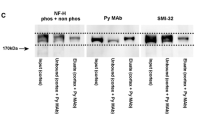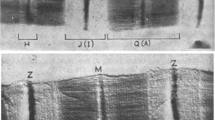Abstract
Large amounts of a neurofilament-enriched fraction may be prepared from spinal cord homogenates by a simple, three-step procedure. This involves flotation of filament-containing axon fragments, extraction with Triton X-100, and washing by sedimentation through a sucrose density gradient. The material obtained by this procedure includes both large mats of individual 10-nm filaments and tightly packed bundles of filaments. SDS-gel electrophoresis of these fractions indicates that the fractions are formed of four polypeptides: the three which are generally considered to form neurofilaments (P200, P150, and P68) and another, with a molecular weight of about 50,000 daltons (P50), which is thought to be derived from fibrous astrocytes. Analysis of these filament fractions on two-dimensional gels indicates heterogeneity among each of the different molecular weight classes. The largest polypeptide of neurofilaments, P200, focuses at several spots in the pH gradient. P68 and P150 are more acidic: each appears as a pair of overlapping spots. P50 resolves into a complex of spots of about the same molecular weight but with different isoelectric points. Heterogeneity is not unique to these filament polypeptides but appears to be a characteristic of all fibrous proteins of the nervous system.
Similar content being viewed by others
References
Marotta, C. A., Strocchi, P., andGilbert, J. M. 1978. Microheterogeneity of brain cytoplasmic and synaptoplasmic actins. J. Neurochem. 30:1441–1451.
Feit, H. Neudeck, U., andBaskin, F. 1977. Comparison of the isoelectric and molecular weight properties of tubulin subunits. J. Neurochem. 28:697–706.
Lu, R. C., andElzinga, M. 1977. Chromatographic resolution of the subunits of calf brain tubulin. Anal. Biochem. 77:243–250.
Gozes, I., andLittauer, U. Z. 1978. Tubulin microheterogeneity increases with rat brain maturation. Nature 276:411–413.
Marotta, C. A., Harris, J. L., andGilbert, J. M. 1978. Characterization of multiple forms of brain tubulin subunits. J. Neurochem. 30:1431–1440.
Dahl, J. L., andWeibel, V. J. 1979 Changes in tubulin heterogeneity during postnatal development of rat brain. Biochem. Biophys. Res. Commun. 86:822–828.
Shelanski, N. L., andFeit, H. 1972. Filaments and tubules in the nervous system. Pages 47–80,in Bourne, G. H. (ed.), The Structure and Function of Nervous Tissue, Vol. 6, Academic Press, New York.
Wuerker, R. B., andKirkpatrick, J. B. 1972. Neuronal microtubules, neurofilaments and microfilaments. Int. Rev. Cytol. 33:45–75.
Hoffman, P. N., andLasek, R. J. 1975. The slow component of axonal transport. Identification of major structural polypeptides of axon and their generality among mammalian neurons. J. Cell Biol. 66:351–366.
Schlaepfer, W. W., andFreeman, L. 1978. Neurofilament proteins of rat peripheral nerve and spinal cord. J. Cell Biol. 78:653–662.
Liem, R. K. H., Yen, S. N., Salomon, G. D., andShelanski, M. L. 1978. Intermediate filaments in nervous tissues. J. Cell Biol. 79:637–645.
Eng, L. F., Vanderhaeghen, J. J., Bignami, A., andGerstl, B. 1971. An acidic protein isolated from fibrous astrocytes. Brain Res. 28:351–354.
Goldman, J. E., Schaumburg, H. H., andNorton, W. T. 1978. Isolation and characterization of glial filaments from human brain. J. Cell Biol. 78:426–440.
Shelanski, M. L., Albert, S., DeVries, G. H., andNorton, W. T. 1971. Isolation of filaments from brain. Science 174:1242–1245.
DeVries, G. H., Norton, W. T., andRaine, C. S. 1972. Axons: Isolation from mammalian central nervous system. Science 175:1370–1372.
Yen, S.-H., Dahl, D., Schachner, M., andShelanski, M. 1976. Biochemistry of the filaments from brain. Proc. Natl. Acad. Sci. U.S.A. 73:529–533.
Davison, P. F., andHong, B.-S. 1977. Structural homologies in mammalian neurofilament proteins. Brain Res. 134:287–295.
Thorpe, R., Delacourte, A., andAnderton, B. H. 1979. The isolation of brain 10 nm filaments polypeptides from urea extracts of brain white matter. FEBS Lett. 103:148–151.
Schlaepfer, W. W. 1977. Studies on the isolation and substructure of mammalian neurofilaments. J. Ultrastruct. Res. 76:50–56.
Runge, M. S., Detrich, H. W., III, andWilliams, R. C., Jr. 1979. Identification of the major 68,000-dalton protein of microtubule preparations as a 10-nm filament protein and its effect on microtubule assembly in vitro. Biochemistry 18:1689–1698.
Czosnek, H., Soifer, D., Hochberg, A., andWisniewski, H. M. 1979. Isolation and characterization of free and membrane-bound polyribosomes from rabbit spinal cord. J. Neurosci. Methods 1:327–341.
Czosnek, H., Soifer, D., andWisniewski, H. M. 1980. Studies on the biosynthesis of neurofilament proteins. J. Cell Biol. 85:726–734.
Laemmli, U. K. 1970. Cleavage of structural proteins during the assembly of the head of bacteriophage T4. Nature 227:680–685.
O'Farrell, P. 1975. High resolution two-dimensional electrophoresis of proteins. J. Biol. Chem. 250:4007–4021.
Bradford, M. M. 1976. A rapid and sensitive method for the quantitation of microgram quantities of protein utilizing the principle of protein-dye binding. Anal. Biochem. 72:248–254.
Folch, J., Lees, M., andSloane-Stanley, G. H. 1957. A simple method for the isolation and purification of total lipids from animal tissues. J. Biol. Chem. 226:497–509.
Bartlett, G. R. 1959. Phosphorus assay in column chromatography. J. Biol. Chem. 234:466–468.
Bloemendal, H., Bont, W. S., DeVries, M., andBenedetti, E. L. 1967. Isolation and properties of polyribosomes and fragments of the endoplasmic reticulum from rat liver. Biochem. J. 103:177–182.
Spurr, A. R. 1969. A low viscosity epoxy resin embedding medium for electron microscopy. J. Ultrastruct. Res. 26:31–43.
Reynolds, E. S. 1963. The use of lead citrate at high pH as an electron opaque stain in electron microscopy. J. Cell Biol. 17:208–212.
Benitz, W. E., Dahl, D., Williams, K. W., andBignami, A. 1976. The protein composition of glial and nerve fibers. FEBS Lett. 66:285–289.
DeVries, G. H., Eng, L. F., Lewis, D. L., andHadfield, M. G. 1976. The protein composition of bovine myelin-free axons. Biochim. Biophys. Acta 439:133–145.
Anderton, B. H., Ayers, M., andThorpe, R. 1978. Neurofilaments from mammalian central and peripheral nerve share certain polypeptides. FEBS Lett. 96:159–163.
Dahl, D. 1979. The cyanogen bromide peptide maps of neurofilament polypeptides in axonal preparations isolated from bovine brain are different. FEBS Lett. 103:144–147.
Wang, K., Ash, J. F., andSinger, S. J. 1975. Filamin, a new high-molecular-weight protein found in smooth muscle and non-muscle cells. Proc. Natl. Acad. Sci. U.S.A. 72:483–486.
Czosnek, H., Soifer, D., andWisniewski, H. M. 1979. Are the triplet polypeptides of neurofilaments formed by proteolytic degradation? J. Cell Biol. 83 (2pt II). 478a (abstract).
Marotta, C. A., Strocchi, P., andGilbert, J. M. 1979. Biosynthesis of heterogeneous forms of mammalian brain tubulin subunits by multiple messenger RNAs. J. Neurochem. 33:231–246.
Willard, M. B. 1976. A genetically-determined protein polymorphism in the rabbit nervous system. Proc. Natl. Acad. Sci. U.S.A. 73:3641–3645.
Soifer, D., Iqbal, K., De Martini, J., Sturman, J. A., andWisniewski, H. M. 1980. Protein changes associated with Wallerian degeneration. Trans. Am. Soc. Neurochem. 11:79 (abstract).
Forgue, S. T., andDahl, J. L. 1979. Rat brain tubulin: subunit heterogeneity and phosphorylation. J. Neurochem. 32:1015–1025.
Scheket, G., andLasek, R. J. 1979. Phosphorylation of neurofilaments from mammalian peripheral nerve. Trans. Am. Soc. Neurochem. 10:140 (abstract).
Author information
Authors and Affiliations
Rights and permissions
About this article
Cite this article
Czosnek, H., Soifer, D. & Wisniewski, H.M. Heterogeneity of intermediate filament proteins from rabbit spinal cord. Neurochem Res 5, 777–793 (1980). https://doi.org/10.1007/BF00964715
Accepted:
Issue Date:
DOI: https://doi.org/10.1007/BF00964715




